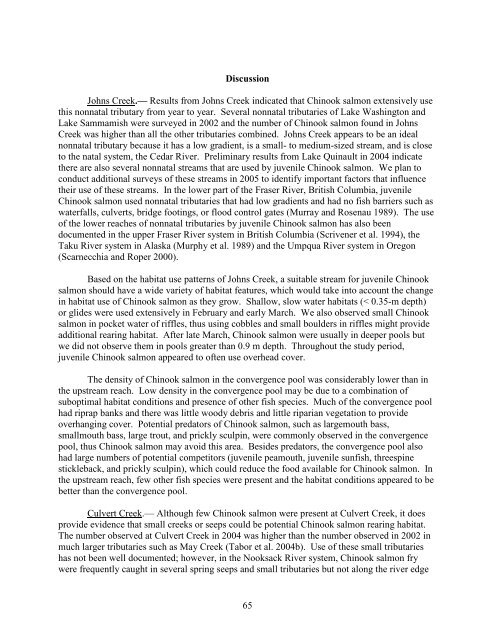Nearshore Habitat Use by Juvenile Chinook Salmon in Lentic ...
Nearshore Habitat Use by Juvenile Chinook Salmon in Lentic ...
Nearshore Habitat Use by Juvenile Chinook Salmon in Lentic ...
You also want an ePaper? Increase the reach of your titles
YUMPU automatically turns print PDFs into web optimized ePapers that Google loves.
Discussion<br />
Johns Creek.— Results from Johns Creek <strong>in</strong>dicated that <strong>Ch<strong>in</strong>ook</strong> salmon extensively use<br />
this nonnatal tributary from year to year. Several nonnatal tributaries of Lake Wash<strong>in</strong>gton and<br />
Lake Sammamish were surveyed <strong>in</strong> 2002 and the number of <strong>Ch<strong>in</strong>ook</strong> salmon found <strong>in</strong> Johns<br />
Creek was higher than all the other tributaries comb<strong>in</strong>ed. Johns Creek appears to be an ideal<br />
nonnatal tributary because it has a low gradient, is a small- to medium-sized stream, and is close<br />
to the natal system, the Cedar River. Prelim<strong>in</strong>ary results from Lake Qu<strong>in</strong>ault <strong>in</strong> 2004 <strong>in</strong>dicate<br />
there are also several nonnatal streams that are used <strong>by</strong> juvenile <strong>Ch<strong>in</strong>ook</strong> salmon. We plan to<br />
conduct additional surveys of these streams <strong>in</strong> 2005 to identify important factors that <strong>in</strong>fluence<br />
their use of these streams. In the lower part of the Fraser River, British Columbia, juvenile<br />
<strong>Ch<strong>in</strong>ook</strong> salmon used nonnatal tributaries that had low gradients and had no fish barriers such as<br />
waterfalls, culverts, bridge foot<strong>in</strong>gs, or flood control gates (Murray and Rosenau 1989). The use<br />
of the lower reaches of nonnatal tributaries <strong>by</strong> juvenile <strong>Ch<strong>in</strong>ook</strong> salmon has also been<br />
documented <strong>in</strong> the upper Fraser River system <strong>in</strong> British Columbia (Scrivener et al. 1994), the<br />
Taku River system <strong>in</strong> Alaska (Murphy et al. 1989) and the Umpqua River system <strong>in</strong> Oregon<br />
(Scarnecchia and Roper 2000).<br />
Based on the habitat use patterns of Johns Creek, a suitable stream for juvenile <strong>Ch<strong>in</strong>ook</strong><br />
salmon should have a wide variety of habitat features, which would take <strong>in</strong>to account the change<br />
<strong>in</strong> habitat use of <strong>Ch<strong>in</strong>ook</strong> salmon as they grow. Shallow, slow water habitats (< 0.35-m depth)<br />
or glides were used extensively <strong>in</strong> February and early March. We also observed small <strong>Ch<strong>in</strong>ook</strong><br />
salmon <strong>in</strong> pocket water of riffles, thus us<strong>in</strong>g cobbles and small boulders <strong>in</strong> riffles might provide<br />
additional rear<strong>in</strong>g habitat. After late March, <strong>Ch<strong>in</strong>ook</strong> salmon were usually <strong>in</strong> deeper pools but<br />
we did not observe them <strong>in</strong> pools greater than 0.9 m depth. Throughout the study period,<br />
juvenile <strong>Ch<strong>in</strong>ook</strong> salmon appeared to often use overhead cover.<br />
The density of <strong>Ch<strong>in</strong>ook</strong> salmon <strong>in</strong> the convergence pool was considerably lower than <strong>in</strong><br />
the upstream reach. Low density <strong>in</strong> the convergence pool may be due to a comb<strong>in</strong>ation of<br />
suboptimal habitat conditions and presence of other fish species. Much of the convergence pool<br />
had riprap banks and there was little woody debris and little riparian vegetation to provide<br />
overhang<strong>in</strong>g cover. Potential predators of <strong>Ch<strong>in</strong>ook</strong> salmon, such as largemouth bass,<br />
smallmouth bass, large trout, and prickly sculp<strong>in</strong>, were commonly observed <strong>in</strong> the convergence<br />
pool, thus <strong>Ch<strong>in</strong>ook</strong> salmon may avoid this area. Besides predators, the convergence pool also<br />
had large numbers of potential competitors (juvenile peamouth, juvenile sunfish, threesp<strong>in</strong>e<br />
stickleback, and prickly sculp<strong>in</strong>), which could reduce the food available for <strong>Ch<strong>in</strong>ook</strong> salmon. In<br />
the upstream reach, few other fish species were present and the habitat conditions appeared to be<br />
better than the convergence pool.<br />
Culvert Creek.— Although few <strong>Ch<strong>in</strong>ook</strong> salmon were present at Culvert Creek, it does<br />
provide evidence that small creeks or seeps could be potential <strong>Ch<strong>in</strong>ook</strong> salmon rear<strong>in</strong>g habitat.<br />
The number observed at Culvert Creek <strong>in</strong> 2004 was higher than the number observed <strong>in</strong> 2002 <strong>in</strong><br />
much larger tributaries such as May Creek (Tabor et al. 2004b). <strong>Use</strong> of these small tributaries<br />
has not been well documented; however, <strong>in</strong> the Nooksack River system, <strong>Ch<strong>in</strong>ook</strong> salmon fry<br />
were frequently caught <strong>in</strong> several spr<strong>in</strong>g seeps and small tributaries but not along the river edge<br />
65
















